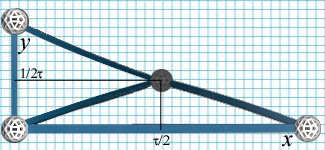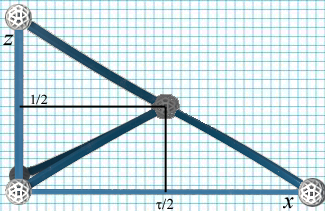Analytic Zome
This page describes the approach taken to
solve the Petersen Graph Zome Challenge from the prizes page of Mathpuzzle.com. If you are more visually inclined, you
might want to start with theVirtual Zome Petersen Graphs
page.
I didn't feel like searching for the solution
by hand (given that it might be impossible)
so I decided to create a computer program
to search for any and all solutions. To do
this, I first needed some way of representing
a Zome ball positioned in space as well as
some nomenclature for describing the various
directions taken from a Zome ball.
Zome Axes
|
The Zome coordinate system I used is a typical
three dimensional (x,y,z) space with
a Zome
ball at the origin and three mutually
perpindicular
blue stuts (i.e. the corner of a cube)
being
the positive axes. Here is a picture
of the
origin and the positive axes as viewed
from
the from the first octant. (Note that
the
images here are taken by placing actual
Zome
pieces on the glass of my scanner and
then
editing the scanned image.)
The positive x axis is pointing to the lower
left, the positive y axis is pointing to
the lower right and the positive z axis is
pointing up. Note that the wider side of
the strut lying on the positive x axis is
parallel to the xy plane, the wider side
of the y axis lies in the yz plane, and the
wider side of the z axis lies in the xz plane.
This is an arbitrary decision (alternatives
are equally valid), but the decision is significant
because the nomenclature and computer program
rely on this particular orientation.
|
 |
Zome Coordinates
Next, I needed a way to represent the coordinates
of Zome balls in this space. I started with
blue struts of the same length since that
is all that the original problem required.
Using 1 as the blue strut length, the coordinates
of the Zome balls at the ends of the six
axes struts are obviously (+/-1, 0, 0), (0,
+/-1, 0), and (0, 0, +/-1). The coordinates
of the remaining 24 neighboring balls are
not so obvious. As you can see from the above
picture, there are three blue (i.e. rectangular)
holes in octant 1. In fact, there are three
blue holes in each of the eight octants (3*8=24).
Due to the symetry of the Zome ball, finding
the coordinates of any one of these 24 balls
will give us the coordinates of the other
23 balls (thanks to rotation and reflection).
I chose to start with the blue hole in octant
one that shares a corner with the positive
x axis. I used a b3 strut as the positive
x axis, a b1 strut as the positive y axis,
and a b2 strut as the positive z axis. I
then placed a b2 strut in the blue hole in
octant 1 next to the x axis. Connecting b2
struts between the ball at the end of the
octant 1 strut and the balls at then ends
of the three axial struts results in the
structure shown in the two images shown here.
|
The upper image is essentially a projection
of the structure onto the xy plane.
The lower
image is a projection onto the xz plane.
If T is the ratio of successive lengths of blue
struts and b2 is taken to have a length of
1, then it is apparent from this structure
that the coordintes of the fourth ball are:
( T/2, 1/(2T), 1/2 )
These three values and their negatives can
be used in different permutations to express
the coordinates of all balls that are at
the ends of non-axial blue struts with length
1.
One interesting thing about these numbers
(including the coordinates of the axial balls)
is that they can all be expressed as:
(a+bT)/2, where a and b are integers
It turns out that this expression can be
used to represent the coordinates of
any ball that is connected (or connectable) to the
origin using any combination of struts of any length (including green struts in any orientation, but not blue green struts). Using 2-tuples
of integers to represent coordinates is ideal
for computer programs because...
- It eliminates rounding errors that can accumulate
when performing floating point math
on digital
computers.
- Integer math is faster than floating point
math.
|
 |
 |
Zome Nomenclature
Now that the coordinates of neighboring Zome
balls can be determined, I needed a nomenclature
to describe the different directions that
can be taken from a Zome ball. Every Zome
ball has 62 holes. The first way to differentiate
the holes is by the color of the strut that
fits into the hole: blue, yellow, or red.
Since yellow starts with a "y"
and y is also used to describe a ball's coordinates
(as in "(x,y,z)"), I decided that
it would reduce confusion if I referred to
struts of that color as "amber struts"
instead of "yellow struts". Here
is a breakdown of the Zome ball's holes:
| Color |
Number per axis/octant |
Number of axes/octants |
Total |
| Blue |
2 per axis |
3 axes |
6 |
| 3 per octant |
8 octants |
24 |
| Amber |
4 per axis |
3 axes |
12 |
| 1 per octant |
8 octants |
8 |
| Red |
4 per axis |
3 axes |
12 |
| Grand Total |
62 |
Further examination of a Zome ball reveals
that each hole (except for 8 amber holes)
is adjacent to an axis or is itself an axis.
I wanted the nomenclature to be as compact
as possible, yet still be readable by humans.
After considering several possibilities,
I finally decided on using the following
three components to refer to a Zome ball
hole: its color, the axis to which it is
adjacent, and the octant in which it lies.
Using one character for each component provides
a three character "name" for each
hole. The characters I used for each component
are shown in the following table.
| Component |
Value |
Symbol |
Comment |
| Color |
Blue |
b |
|
| Amber |
a |
aka Yellow |
| Red |
r |
|
| Axis |
x |
x |
|
| y |
y |
|
| z |
z |
|
| N/A |
o |
This is for the amber holes that are centered
in each octant. |
| Octant |
1-8 |
1-8 |
The numbers 1 through 8 are used for the
8 octants. |
| + |
+ |
This is used for the positive axes. |
| - |
- |
This is used for the negative axes. |
This nomenclature has some ambiguities. For
example, the amber hole directly "above"
the positive x axis lies in the xz plane
and is not really in either octant 1 or octant
4. These ambiguities are resolved by the
following convention: if a hole lies in the
xy, yz, or xz plane, its zero coordinate
is considered to by positive for the purposes
of determining its octant unless the hole opposite it has already been assigned
an octant. In that case, the hole is assigned
the octant opposite the opposite hole's octant.
Octants are assigned to holes starting with
those in or around octant 1 and ending with
those in or around octant 8. Some examples
will probably clear up any confusion you
may have...
The three positive axes are referred to as
bx+, by+, and bz+. The hole that was used above to determine
the non-axial coordinates was hole bx1. The amber hole directly above the x axis
is called ax1, the amber hole directly above the negative
x axis is called ax2, the amber hole directly below the negative
x axis is ax7, and the amber hole directly below the positive
x axis is called ax8. The amber hole that is in the "center"
of octant 1 is called ao1 (think "o for other" or "o
for octant"). Here are the names of
all 62 holes:
| Positive Axes: |
bx+ |
by+ |
bz+ |
|
|
|
|
|
|
|
| Octant I: |
bx1 |
by1 |
bz1 |
ax1 |
ay1 |
az1 |
ao1 |
rx1 |
ry1 |
rz1 |
| Octant II: |
bx2 |
by2 |
bz2 |
ax2 |
ay2 |
ao2 |
rx2 |
rz2 |
|
|
| Octant III: |
bx3 |
by3 |
bz3 |
ao3 |
|
|
|
|
|
|
| Octant IV: |
bx4 |
by4 |
bz4 |
az4 |
ao4 |
ry4 |
|
|
|
|
| Negative Axes: |
bx- |
by- |
bz- |
|
|
|
|
|
|
|
| Octant V: |
bx5 |
by5 |
bz5 |
ao5 |
|
|
|
|
|
|
| Octant VI: |
bx6 |
by6 |
bz6 |
az6 |
ao6 |
ry6 |
|
|
|
|
| Octant VII: |
bx7 |
by7 |
bz7 |
ax7 |
ay7 |
az7 |
ao7 |
rx7 |
ry7 |
rz7 |
| Octant VIII: |
bx8 |
by8 |
bz8 |
ax8 |
ay8 |
ao8 |
rx8 |
az8 |
|
|
Representing Zome Constructions
If all of the struts of a Zome construction
have the same length, then the hole names
are adequate to describe the neighboring
Zome balls. If the struts have different
lengths, then a size indicator (1, 2, 3)
can be added after the color letter to indicate
the length of the strut placed in that hole.
A series of such names can be used to specify
a particular arrangement of Zome balls and
struts. For example, a square can be represented
as bx+, by+, bx-, by-. An equilateral triangle can be represented
as bx+, by2, by7.
The Zome construction used above to determine
the coordinates of non-axial blue balls can
be described as:
b3x+, b2x2, b2x7, b2z+, b2x8, b2x6, b1y-
On to the Petersen Graph...
Having established a coordinate system and
a means of representing Zome constructions,
it is now time to move on to actually solving the Petersen Graph Zome Challenge.
Copyright © 2001 Smart Software Consulting


